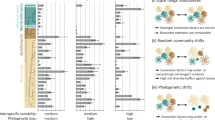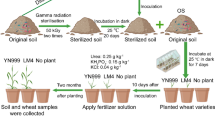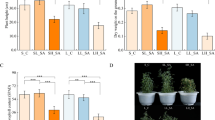Abstract
Members of the phylum Planctomycetes are common inhabitants of northern Sphagnum-dominated wetlands. Evidence is accumulating that, in these environments, some planctomycetes may be involved in degrading polymeric organic matter. The experimental data, however, remain scarce due to the low number of characterized representatives of this phylum. In a previous study, we used metatranscriptomics to assess the activity response of peat-inhabiting microorganisms to biopolymers abundantly present in native peat. The community responses to cellulose, xylan, pectin, and chitin availability were analysed relative to unamended controls. Here, we re-analysed these metatranscriptomes and retrieved a total of 1,602,783 rRNA and 35,522 mRNA sequences affiliated with the Planctomycetes. Each of the four polymers induced specific planctomycete responses. These were most pronounced on chitin. The two groups with increased 16S rRNA transcript pools were Gemmata- and Phycisphaera-like planctomycetes. Among uncultivated members of the Planctomycetaceae, two increased transcript pools were detected in pectin-amended samples and belonged to Pirellula-like bacteria. The analysis of taxonomically assigned mRNA reads confirmed the specific response of Gemmata-related planctomycetes to chitin amendment suggesting the presence of chitinolytic capabilities in these bacteria.




Similar content being viewed by others
References
Altschul SF, Madden TL, Schäffer AA et al (1997) Gapped BLAST and PSI-BLAST: a new generation of protein database search programs. Nucleic Acids Res 25:3389–3402
Ballance S, Børsheim KY, Inngjerdingen K et al (2007) A re-examination and partial characterisation of polysaccharides released by mild acid hydrolysis from the chlorite-treated leaves of Sphagnum papillosum. Carbohydr Polym 67:104–115. https://doi.org/10.1016/j.carbpol.2006.04.020
Bastian M, Heymann S, Jacomy M (2009) Gephi: an open source software for exploring and manipulating networks. In: Third International AAAI Conference on Weblogs and Social Media. pp 361–362
Bayer EA, Aviv R (2013) Lignocellulose-decomposing bacteria and their enzyme systems. In: Rosenberg E, DeLong EF, Lory S et al (eds) The prokaryotes. Springer, Berlin, pp 578–617
Bragina A, Berg C, Cardinale M et al (2012) Sphagnum mosses harbour highly specific bacterial diversity during their whole lifecycle. ISME J 6:802–813. https://doi.org/10.1038/ismej.2011.151
Caporaso J, Kuczynski J, Stombaugh J (2010) QIIME allows analysis of high-throughput community sequencing data. Nat Methods 7:335–336. https://doi.org/10.1038/nmeth0510-335
Dedysh SN, Kulichevskaya IS (2013) Acidophilic Planctomycetes: expanding the horizons of new planctomycete diversity. In: Fuerst JA (ed) Planctomycetes: cell structure. Humana Press, Origins and Biology, pp 125–139
Dedysh SN, Pankratov TA, Belova SE et al (2006) Phylogenetic analysis and in situ identification of bacteria community composition in an acidic Sphagnum peat bog. Appl Environ Microbiol 72:2110–2117. https://doi.org/10.1128/AEM.72.3.2110-2117.2006
Edgar RC (2010) Search and clustering orders of magnitude faster than BLAST. Bioinformatics 26:2460–2461. https://doi.org/10.1093/bioinformatics/btq461
Eichorst SA, Kuske CR (2012) Identification of cellulose-responsive bacterial and fungal communities in geographically and edaphically different soils by using stable isotope probing. Appl Environ Microbiol 78:2316–2327. https://doi.org/10.1128/AEM.07313-11
Fuerst JA (1995) The Planctomycetes: emerging models for microbial ecology, evolution and cell biology. Microbiology 141:1493–1506. https://doi.org/10.1099/13500872-141-7-1493
Fuerst JA, Sagulenko E (2011) Beyond the bacterium: planctomycetes challenge our concepts of microbial structure and function. Nat Rev Microbiol 9:403–413. https://doi.org/10.1038/nrmicro2578
Huson DH, Mitra S, Ruscheweyh H-J et al (2011) Integrative analysis of environmental sequences using MEGAN4. Genome Res 21:1552–1560. https://doi.org/10.1101/gr.120618.111
Ivanova AO, Dedysh SN (2012) Abundance, diversity, and depth distribution of Planctomycetes in acidic northern wetlands. Front Microbiol. https://doi.org/10.3389/fmicb.2012.00005
Ivanova AA, Kulichevskaya IS, Merkel AY et al (2016a) High diversity of Planctomycetes in soils of two lichen-dominated sub-arctic ecosystems of northwestern Siberia. Front Microbiol 7:2065. https://doi.org/10.3389/fmicb.2016.02065
Ivanova AA, Wegner CE, Kim Y et al (2016b) Identification of microbial populations driving biopolymer degradation in acidic peatlands by metatranscriptomic analysis. Mol Ecol 25:4818–4835. https://doi.org/10.1111/mec.13806
Ivanova AA, Naumoff DG, Miroshnikov KK et al (2017) Comparative genomics of four Isosphaeraceae planctomycetes: a common pool of plasmids and glycoside hydrolase genes shared by Paludisphaera borealis PX4T, Isosphaera pallida IS1BT, Singulisphaera acidiphila DSM 18658T, and strain SH-PL62. Front Microbiol 8:412. https://doi.org/10.3389/fmicb.2017.00412
Kanokratana P, Uengwetwanit T, Rattanachomsri U et al (2011) Insights into the phylogeny and metabolic potential of a primary tropical peat swamp forest microbial community by metagenomic analysis. Microb Ecol 61:518–528. https://doi.org/10.1007/s00248-010-9766-7
Kopylova E, Noé L, Touzet H (2012) SortMeRNA: fast and accurate filtering of ribosomal RNAs in metatranscriptomic data. Bioinformatics 28:3211–3217. https://doi.org/10.1093/bioinformatics/bts611
Kovaleva OL, Merkel AY, Novikov AA et al (2015) Tepidisphaera mucosa gen.nov., sp.nov., a moderately thermophilic member of the class Phycisphaerae in the phylum Planctomycetes, and proposal of a new family, Tepidisphaeraceae fam.nov., and a new order, Tepidisphaerales. Int J Syst Evol Microbiol 65:549–555. https://doi.org/10.1099/ijs.0.070151-0
Kremer C, Pettolino F, Bacic A, Drinnan A (2004) Distribution of cell wall components in Sphagnum hyaline cells and in liverwort and hornwort elaters. Planta 219:1023–1035. https://doi.org/10.1007/s00425-004-1308-4
Kulichevskaia IS, Belova SE, Kevbrin VV et al (2007) Analysis of the bacterial community developing in the course of Sphagnum moss decomposition. Mikrobiologiia 76:702–710. https://doi.org/10.1134/S0026261707050165
Kulichevskaya IS, Serkebaeva YM, Kim Y, et al (2012) Telmatocola sphagniphila gen. nov., sp. nov., a novel dendriform planctomycete from northern wetlands. Front Microbiol 3:146. https://doi.org/10.3389/fmicb.2012.00146
Kulichevskaya IS, Ivanova AA, Suzina NE et al (2016) Paludisphaera borealis gen. nov., sp. nov., a hydrolytic planctomycete from northern wetlands, and the proposal of Isosphaeraceae fam. nov. Int J Syst Evol Microbiol 66:837–844. https://doi.org/10.1099/ijsem.0.000799
Masella AP, Bartram AK, Truszkowski JM et al (2012) PANDAseq: paired-end assembler for illumina sequences. BMC Bioinform 13:31. https://doi.org/10.1186/1471-2105-13-31
Mettel C, Kim Y, Shrestha PM, Liesack W (2010) Extraction of mRNA from soil. Appl Environ Microbiol 76:5995–6000. https://doi.org/10.1128/AEM.03047-09
Miller CS, Baker BJ, Thomas BC et al (2011) EMIRGE: reconstruction of full-length ribosomal genes from microbial community short read sequencing data. Genome Biol 12:R44. https://doi.org/10.1186/gb-2011-12-5-r44
Moore EK, Villanueva L, Hopmans EC et al (2015) Abundant trimethylornithine lipids and specific gene sequences are indicative of planctomycete importance at the oxic/anoxic interface in Sphagnum-dominated northern wetlands. Appl Environ Microbiol 81:6333–6344. https://doi.org/10.1128/AEM.00324-15
Neef A, Amann R, Schlesner H, Schleifer KH (1998) Monitoring a widespread bacterial group: in situ detection of planctomycetes with 16S rRNA-targeted probes. Microbiology 144:3257–3266. https://doi.org/10.1099/00221287-144-12-3257
Nogales B, Moore ER, Llobet-Brossa E et al (2001) Combined use of 16S ribosomal DNA and 16S rRNA to study the bacterial community of polychlorinated biphenyl-polluted soil. Appl Environ Microbiol 67:1874–1884. https://doi.org/10.1128/AEM.67.4.1874-1884.2001
Quast C, Pruesse E, Yilmaz P et al (2013) The SILVA ribosomal RNA gene database project: improved data processing and web-based tools. Nucleic Acids Res 41:D590–D596. https://doi.org/10.1093/nar/gks1219
Schlesner H (1994) The development of media suitable for the microorganisms morphologically resembling Planctomyces spp., Pirellula spp., and other Planctomycetales from various aquatic habitats using dilute media. Syst Appl Microbiol 17:135–145
Serkebaeva YM, Kim Y, Liesack W, Dedysh SN (2013) Pyrosequencing-based assessment of the bacteria diversity in surface and subsurface peat layers of a northern wetland, with focus on poorly studied phyla and candidate divisions. PLoS ONE 8:e63994. https://doi.org/10.1371/journal.pone.0063994
Stankiewicz A, Briggs D, Evershed R et al (1998) The fate of chitin in quaternary and tertiary strata. In: Stankiewicz A, Van Bergen P (eds) Nitrogen-containing macromolecules in the bio- and geosphere. American Chemical Society, Wahington DC, pp 211–224
Steger D, Wentrup C, Braunegger C et al (2011) Microorganisms with novel dissimilatory (bi)sulfite reductase genes are widespread and part of the core microbiota in low-sulfate peatlands. Appl Environ Microbiol 77:1231–1242. https://doi.org/10.1128/AEM.01352-10
Wang J, Jenkins C, Webb RI, Fuerst JA (2002) Isolation of Gemmata-like and Isosphaera-like planctomycete bacteria from soil and freshwater. Appl Environ Microbiol 68:417–422. https://doi.org/10.1128/AEM.68.1.417-422.2002
Wang Q, Garrity GM, Tiedje JM, Cole JR (2007) Naïve Bayesian classifier for rapid assignment of rRNA sequences into the new bacterial taxonomy. Appl Environ Microbiol 73:5261–5267. https://doi.org/10.1128/AEM.00062-07
Weber CF, King GM (2010) Distribution and diversity of carbon monoxide-oxidizing bacteria and bulk bacterial communities across a succession gradient on a Hawaiian volcanic deposit. Environ Microbiol 12:1855–1867. https://doi.org/10.1111/j.1462-2920.2010.02190.x
Acknowledgements
This study was supported by the Program “Molecular and cell biology” of RAS and by the Deutsche Forschungsgemeinschaft (DFG) through Collaborative Research Center SFB 987. A.I. was also supported by the Russian Foundation for Basic Research (Project No. 16-34-00002).
Author information
Authors and Affiliations
Corresponding author
Ethics declarations
Conflict of interest
The authors declare that they have no conflict of interest.
Electronic supplementary material
Below is the link to the electronic supplementary material.
Rights and permissions
About this article
Cite this article
Ivanova, A.A., Wegner, CE., Kim, Y. et al. Metatranscriptomics reveals the hydrolytic potential of peat-inhabiting Planctomycetes . Antonie van Leeuwenhoek 111, 801–809 (2018). https://doi.org/10.1007/s10482-017-0973-9
Received:
Accepted:
Published:
Issue Date:
DOI: https://doi.org/10.1007/s10482-017-0973-9




